NDVI stands for "Normalized Difference Vegetation Index". NRG stands for "Near-infrared / Red / Green". NDVI and NRG are both ways to visualize the amounts of infrared and other wavelengths of light reflected from vegetation. Because both these methods compare ratios of blue and red light absorbed versus green and IR light reflected, they can be used to evaluate the health of vegetation. It's a snapshot of how much photosynthesis is happening. This is helpful in assessing vegetative health or stress. (Read more here: https://www.agronomy.org/publications/jeq/articles/36/3/832) ## Do-It-Yourself These techniques for vegetation analysis were developed for satellite imagery, but at Public Lab, we've been working a lot on capturing infrared imagery using our DIY [near-infrared camera](/wiki/near-infrared-camera) setup, and combining it with visible bands to produce NDVI images such as the one above. ## What these images mean What exactly are these images we're trying to make? What do they tell us about vegetation, and why? These diagrams should help to understand what it is we're doing and why these are good ways to analyze plant life. ## The NDVI equation [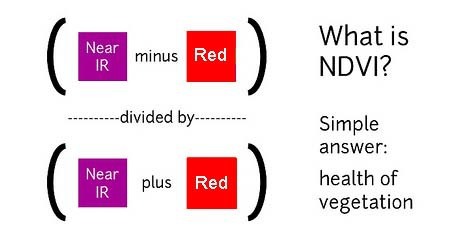](/i/44723) **NDVI = (Near Infrared - Red)/(Near Infrared + Red)** NDVI is a ratio which tries to emphasize photosynthesis while filtering out sun glare. The above equation is run for every pixel, using source data from an infrared photo and a visible light photo, like this pair: [](https://publiclab.org/system/images/photos/000/021/771/original/5390895115_c9d4d38fec_o.jpg) The result can be false-colored to make the high-photosynthesis areas more clear, and used to examine where plants are and how healthy they are. [](https://publiclab.org/system/images/photos/000/021/770/original/PetVISNDVIcomp.png) _Figure above: Normal color photo (right) and normalized difference vegetation index (NDVI) image (left). NDVI image was derived from two color channels in a single photo taken with a camera modified with a special infrared filter. Note that tree trunks, brown grass, and rocks have very low NDVI values because they are not photosynthetic. Healthy plants typically have NDVI values between 0.1 and 0.9. -- @cfastie_ ### Activities Here are a range of activities you can do to produce and interpret your own NDVI imagery, whether downloaded from a satellite imagery provider or [collected yourself using a DIY technique](/wiki/multispectral-imaging) [activities:ndvi] ****   Most DIY converted cameras today (those from Public Lab) use RGN instead of NRG, so the blue channel represents infrared instead of the red channel. That looks like this: [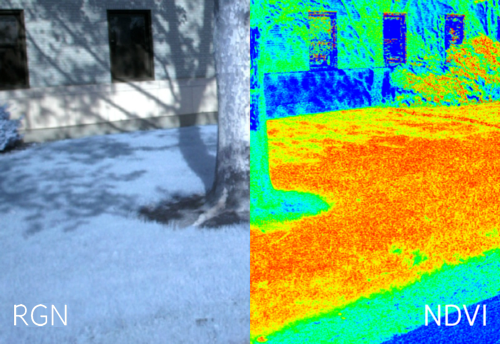](/i/45468?s=o) **** ## NRG imagery Some people are also interested in producing NRG imagery (like the below image), where `Near-Infrared, Red, and Green` are used to compose a picture instead of the usual `Red, Green, and Blue`. [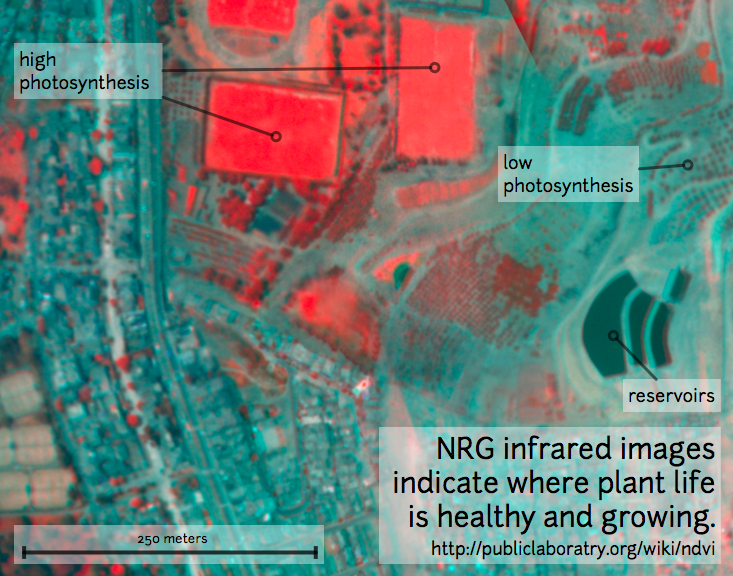](/i/25064) This diagram explains the swapping, which allows us to 'see' infrared as if it were a normal color: [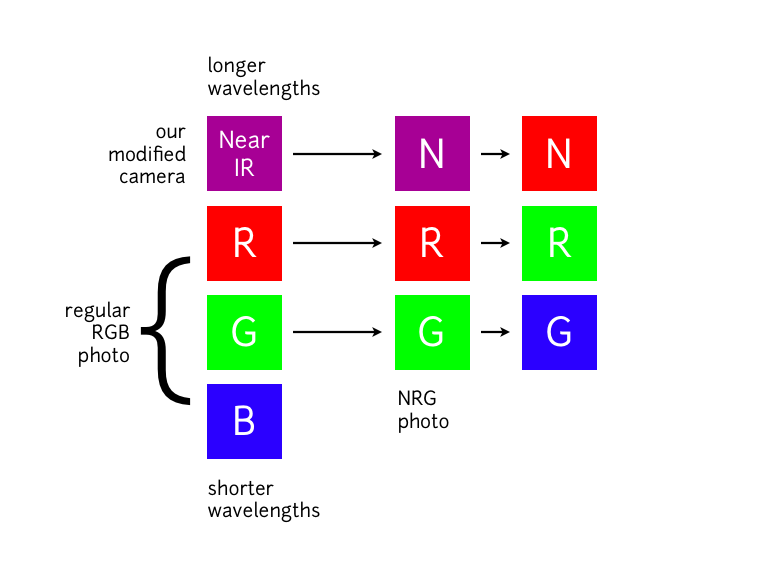](/i/25063) **In NRG images, the deeper and clearer the red color, the denser and healthier the vegetation (more or less).** ### Questions [questions:ndvi] ### Other examples of DIY NDVI imaging From around the internet: Begin watching at 2 minutes to see the resulting imagery: *This topic is part of the [Grassroots Mapping Curriculum](/wiki/mapping-curriculum) series.* **** [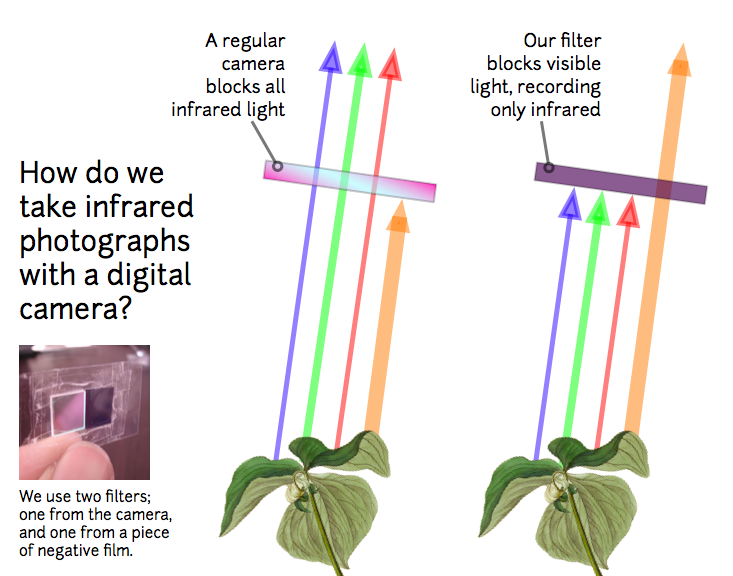](/i/25066) [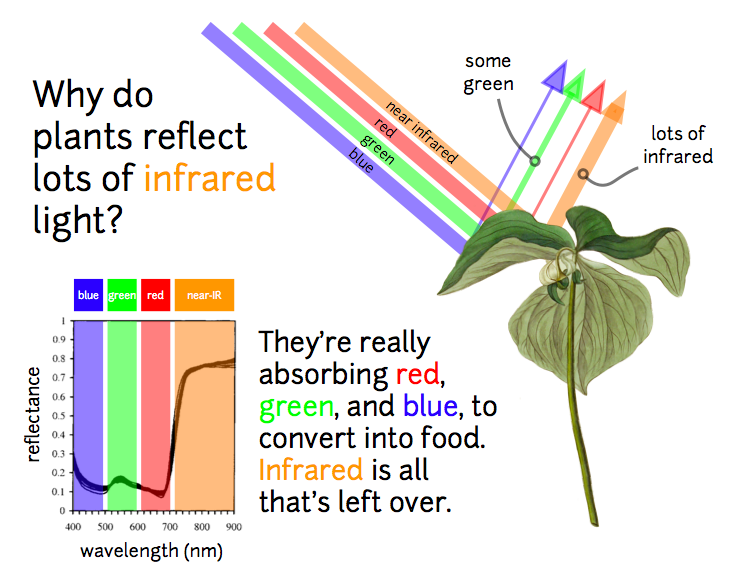](/i/25065) ...
| Author | Comment | Last activity | Moderation | ||
|---|---|---|---|---|---|
| Kalarav | "@cfastie : HI cfastie, Thanks for your kind response. I am using modified camera in these cameras I'm using customized lenses 1. Red bandpass 650 2..." | Read more » | over 7 years ago | |||
| jarrarte | "Hi Kalarav, These links may be good resources for aligning the NIR and RGB images on your project: Blog post: http://www.learnopencv.com/image-al..." | Read more » | over 7 years ago | |||
| cfastie | "It will be important to modify your two camera system so the photo pairs capture the same scene. It will also be important to align the two photos ..." | Read more » | over 7 years ago | |||
| kanakiyab | "I am also trying to figure out the exact problem. Please let me know if you have found an answer to this. Otherwise, I will have to dig deeper into..." | Read more » | over 7 years ago | |||
| cfastie | "With this filter in front of your camera lens, the photos captured will include mostly near infrared light. There will be some visible light includ..." | Read more » | over 7 years ago | |||
| suman | "Hello Ned, I tried using different exposure settings now, and its working, the pixels aren't saturated anymore. Thank you so much for your prompt ..." | Read more » | over 7 years ago | |||
| nedhorning | "Hi Suman - Using Analyze => Measure should work. It's not uncommon to have high pixel values for bright targets. In fact if the exposure isn't s..." | Read more » | over 7 years ago | |||
| suman | "Thank you so much for your prompt response Ned... " | Read more » | over 7 years ago | |||
| suman | "Ohh I get it now. Actually the data has 3 calibration target, but i plan to increase it to 5 targets. I also wanted to know, how i can manually me..." | Read more » | over 7 years ago | |||
| nedhorning | "Hi Suman - The values from 0 - 1 have been scaled from the original image. The reason I do this is that some image pixel values range from 0 - 255 ..." | Read more » | over 7 years ago | |||
| suman | "Dear Ned Horning, I calculated image calibration coefficients, using the reflectance data from department's spectrometer and 3 calibration targets..." | Read more » | over 7 years ago | |||
| nedhorning | "How about testing it on subsets of satellite imagery? You can pick the 3 bands and the band order you want for the testing and can compare that to ..." | Read more » | over 7 years ago | |||
| ccpandhare | "Thanks for the amazing explanation and reference, @warren! I'll be grateful for your help @nedhorning and @warren :) " | Read more » | over 7 years ago | |||
| warren | "Hi, Ned - i'm not asking about calibration at this point, just for a way to empirically test (in the sense of automated testing -- https://en.wikip..." | Read more » | over 7 years ago | |||
| cfastie | "The photos were processed with the Photo Monitoring plugin for FIJI which has a complete users guide. If you have any questions you can describe an..." | Read more » | over 7 years ago | |||
| saangpe | "You could give more details about how to process the images with Fiji and tried to replicate this but I can not make the results conform to the sca..." | Read more » | over 7 years ago | |||
| cfastie | "Sid, Pretty big difficulties. The sensor does not know what hit it. Each pixel produces a value for brightness (for one channel) which depends on ..." | Read more » | over 7 years ago | |||
| sid | "This is excellent work here! I was wondering how software could help eliminate the tedious task of installing a red/blue filter. If an IR enabled ..." | Read more » | over 7 years ago | |||
| ccpandhare | "Thanks for that @warren! " | Read more » | over 7 years ago | |||
| nedhorning | "Hi Jeff - I think I might be able to help with this but I'm not sure what you are looking for. NDVI is simply an algorithm applied to two bands so ..." | Read more » | over 7 years ago | |||
| warren | "Hey @ccpandhare - just a heads up on this! " | Read more » | over 7 years ago | |||
| warren | "Also see this page collecting cheap cameras of this type: https://publiclab.org/questions/warren/05-20-2017/cheap-lightweight-gopro-alternatives-fo..." | Read more » | over 7 years ago | |||
| warren | "These or similar cameras are as low as $40 now! https://www.amazon.com/gp/aw/d/B01DG9UMS6/ref=mp_s_a_1_2?ie=UTF8&qid=1497436247&sr=8-2&..." | Read more » | over 7 years ago | |||
| warren | "Hi! The Mobius can be used as a webcam, and a converted lens is available in the store: https://publiclab.myshopify.com/collections/diy-infrared-ph..." | Read more » | over 7 years ago |